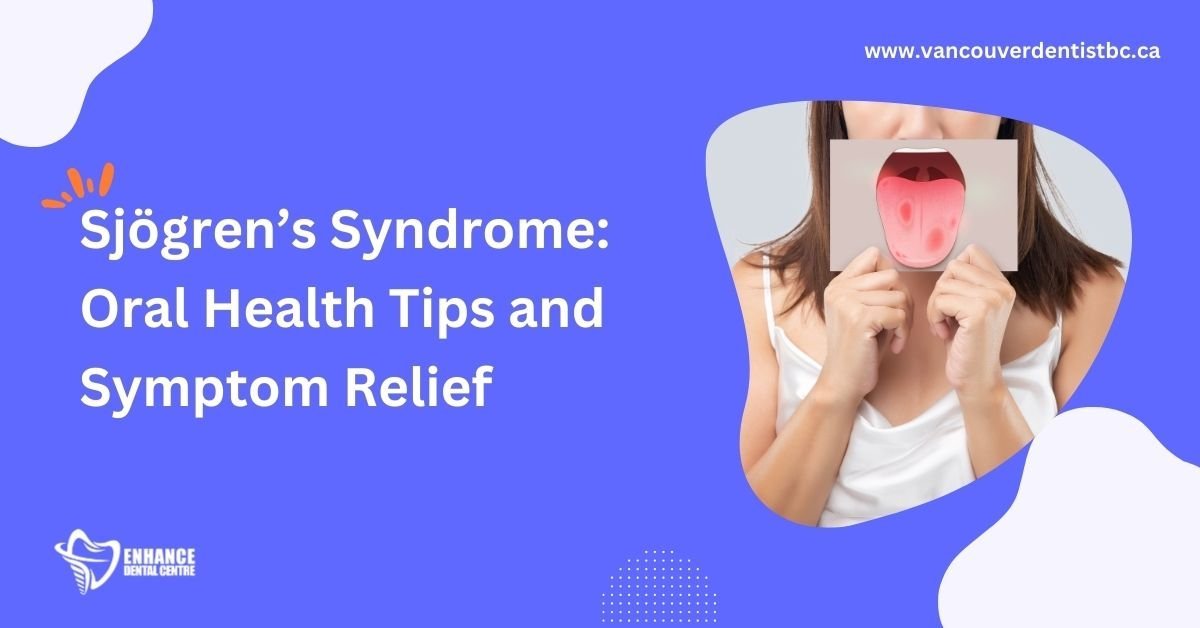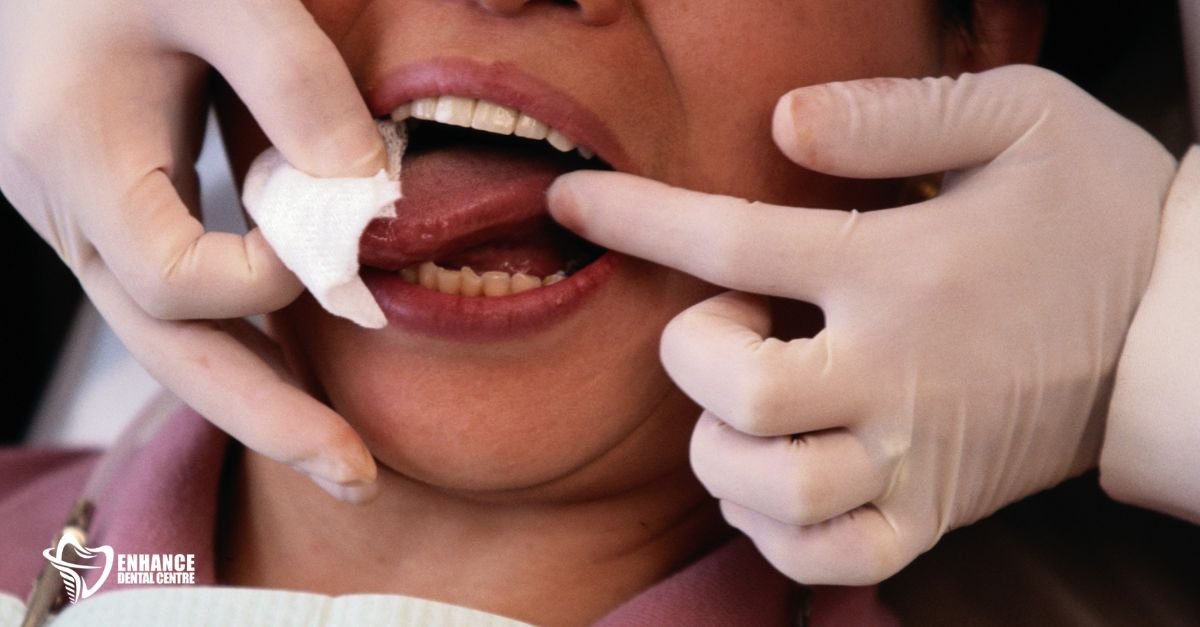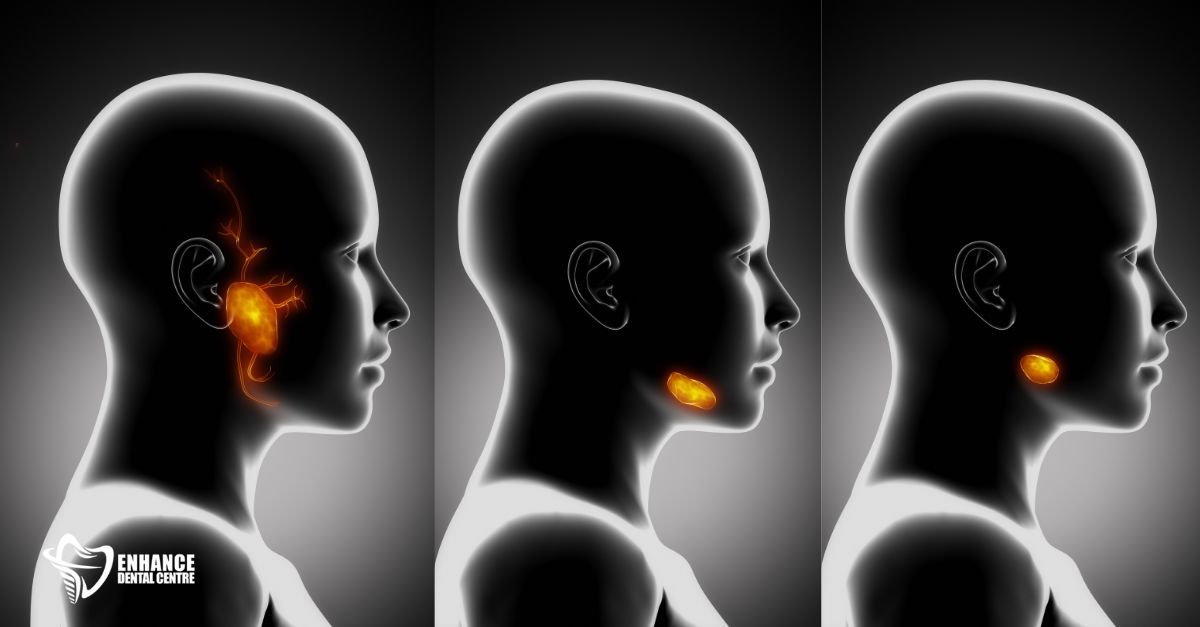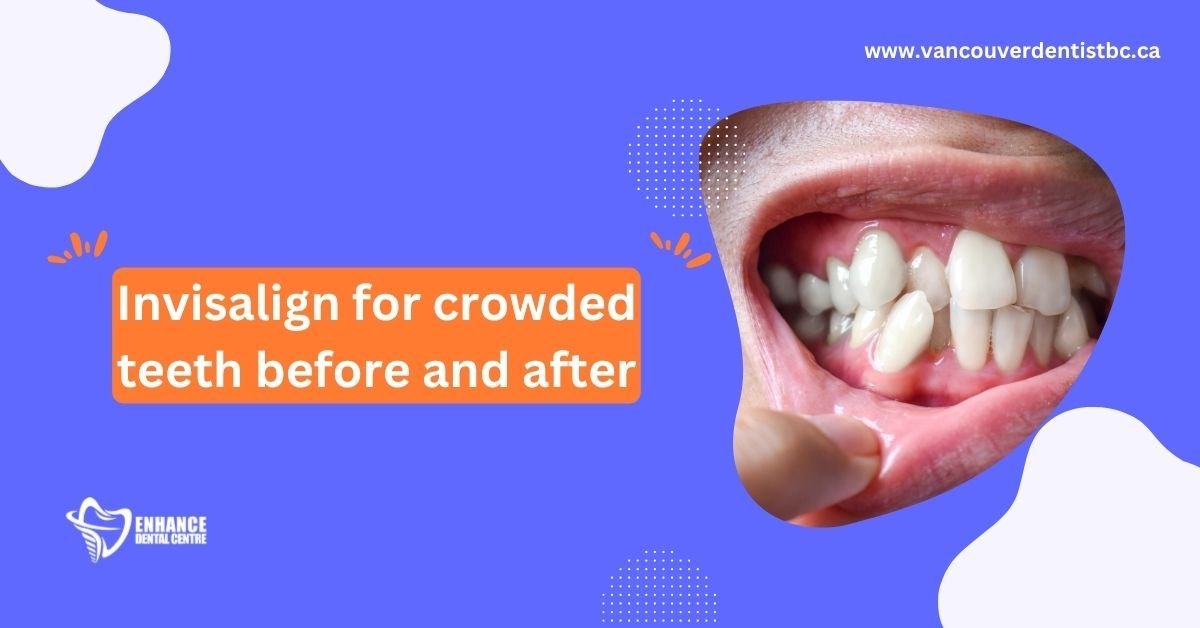Living with dry mouth, gritty eyes, or unexplained fatigue can be confusing—especially if the cause is unclear. For many adults, particularly women aged 40 to 60, these signs may point to Sjögren’s syndrome, a commonly underdiagnosed autoimmune condition.
Sjögren’s syndrome affects the body’s moisture-producing glands, leading to dryness in the eyes, mouth, and other areas. The oral effects can be especially disruptive, increasing the risk of cavities, infections, and daily discomfort.
Understanding the connection between autoimmune disorders and oral health is an important step toward managing your symptoms. Whether you’ve recently been diagnosed or are exploring possible causes, this guide offers practical tools to help you take control.
At Enhance Dental Centre, we understand how much oral health affects your overall comfort and confidence. That’s why we’ve created this resource—to explain what Sjögren’s syndrome is, help you identify symptoms, and share real-world tips to protect your smile and feel better every day.
What is Sjögren’s syndrome?
Sjögren’s syndrome (pronounced SHOW-gren’s) is a chronic autoimmune disease that affects the body’s moisture-producing glands—especially those responsible for saliva and tears. Over time, the immune system mistakenly attacks these glands, reducing their function.
This results in long-term dryness, most often in the eyes and mouth, but it can also affect the nose, throat, digestive tract, and vaginal tissues.
If you notice new or worsening dryness—especially when paired with fatigue or discomfort—it’s important to speak with a healthcare provider. Early diagnosis can help prevent complications and improve quality of life.
What Causes Sjögren’s Syndrome?
The exact cause of Sjögren’s syndrome isn’t fully understood. Most researchers believe it develops from a combination of genetic factors and environmental triggers, such as infections.
You may inherit certain genes that increase your risk, but the condition often activates when the immune system is disrupted by an external factor—most commonly a virus or bacterial infection.
Primary vs. Secondary Sjögren’s Syndrome
Sjögren’s syndrome occurs in two main forms:
- Primary Sjögren’s syndrome: Develops on its own, without any underlying autoimmune disease.
- Secondary Sjögren’s syndrome: Occurs alongside another condition, usually another autoimmune disorder.
Knowing the type you have can help guide treatment and anticipate related health risks.
Health Conditions and Triggers That May Be Linked
Some autoimmune conditions and viral infections have been associated with the development of secondary Sjögren’s syndrome. While having these does not guarantee you’ll develop the syndrome, they may increase risk.
Autoimmune conditions commonly linked:
- Rheumatoid arthritis
- Psoriatic arthritis
- Lupus
Viral infections that may act as triggers:
- Hepatitis C
- Cytomegalovirus (CMV)
- Epstein-Barr virus
- Human T-lymphotropic virus 1 (HTLV-1)
- COVID-19
If you’ve experienced any of these illnesses and begin to notice symptoms like unusual dryness, it’s worth speaking with a healthcare provider.
Who is more likely to develop Sjogren’s syndrome?
Sjögren’s syndrome can affect anyone, but it most commonly occurs in women between the ages of 40 and 60. In fact, about nine out of ten people diagnosed with the condition are women.
You may also be at higher risk if you have a history of autoimmune disease. In these cases, Sjögren’s may appear alongside conditions like lupus or rheumatoid arthritis—this is referred to as secondary Sjögren’s syndrome.
Those without an existing autoimmune diagnosis are said to have primary Sjögren’s syndrome, which occurs independently.
While it’s less common in younger adults and men, Sjögren’s syndrome is often underdiagnosed—especially when symptoms develop slowly or are mistaken for other conditions like menopause, chronic fatigue, or depression.
If you’re experiencing persistent dryness, fatigue, or unexplained oral issues, it’s important to advocate for testing and follow up with both medical and dental professionals.
What are the common symptoms of Sjögren’s syndrome?
The hallmark symptom of Sjögren’s syndrome is persistent dryness, especially in the eyes and mouth. But the condition can affect many systems in the body, often leading to a wide range of symptoms that vary in severity.
Dryness-Related Symptoms:
- Dry or itchy eyes
- Dry mouth, thick or sticky saliva
- Mouth sores or frequent cavities
- Dry nose and frequent nosebleeds
- Dry throat and chronic cough
- Vaginal dryness in women
- Dry, irritated skin
Other Systemic Symptoms:
- Joint or muscle pain
- Swollen lymph nodes
- Constant fatigue
- Brain fog or difficulty concentrating
- Nerve pain or tingling (neuropathy)
- Skin rashes or sensitivity to light
- Indigestion or acid reflux
Oral-Specific Symptoms
Sjögren’s syndrome significantly affects the mouth due to reduced saliva production, leading to chronic discomfort and dental complications.
- Burning or tingling sensations, especially on the tongue or cheeks
- Difficulty speaking or swallowing due to lack of lubrication
- Changes in taste, including metallic or muted flavours
- Frequent cavities, even with good oral hygiene
- Increased risk of oral infections like thrush or gum disease
Recognising these oral changes early can help prevent long-term dental problems and improve your quality of life.
How does Sjögren’s syndrome affect oral health?
Sjögren’s syndrome impacts oral health by reducing saliva production, a condition known as xerostomia. Saliva plays a critical role in keeping the mouth healthy, and when it’s lacking, the risk of dental and soft tissue problems increases significantly.
The Role of Saliva in Oral Hygiene
Saliva does more than keep the mouth moist. It:
- Neutralizes harmful acids
- Washes away food particles and bacteria
- Provides minerals like calcium and phosphate to strengthen enamel
- Aids in chewing, swallowing, and speaking
- Protects against infections by maintaining a balanced oral microbiome
When Sjögren’s affects the salivary glands, these functions are diminished, leading to discomfort and long-term oral health issues.
Effects of Reduced Saliva Production (Xerostomia)
With less saliva, the mouth loses many of its natural defences. This can result in:
- Tooth decay and cavities: Plaque builds up more easily, even with good brushing habits.
- Gum disease: Bacterial overgrowth around the gums can lead to inflammation and infection. Implementing effective periodontal disease prevention strategies becomes essential.
- Oral irritation and infections: Dry tissues are more prone to soreness, cracks, and infections like oral thrush or angular cheilitis.
Recognising these changes early and adjusting your oral care routine can help prevent complications and protect your overall dental health.
Daily Oral Care Tips for Managing Sjögren’s Syndrome
Managing Sjögren’s syndrome starts with a consistent daily routine. These evidence-based strategies support saliva function, ease discomfort, and help protect your teeth and gums.
Hydration and Moisture Maintenance
✔ Sip water regularly: Take small sips throughout the day—even before feeling thirsty—to help rinse away food and bacteria.
✔ Use saliva substitutes as needed: Over-the-counter gels, sprays, or lozenges can temporarily relieve dry mouth discomfort.
✔ Chew sugar-free gum or xylitol mints: These stimulate natural saliva flow while also helping to prevent cavities.
If dryness persists, ask your dentist about chronic dry mouth professional dental care options.
Oral Hygiene for Dry and Sensitive Mouths
Clean gently but thoroughly to prevent decay and gum irritation. Individuals with oral sensitivity should follow oral hygiene for sensitive mouths.
✔ Brush twice daily with fluoride toothpaste to strengthen enamel and resist decay.
✔ Use alcohol-free, fluoride mouthwash to avoid further dryness.
✔ Floss gently once a day to reduce plaque buildup without irritating sensitive gums.
✔ Choose a soft-bristled toothbrush, and replace it every 3 months or sooner if the bristles fray.
Dietary Adjustments
✔ Avoid sugary and acidic foods that accelerate enamel erosion and irritate dry tissues.
✔ Choose moisture-rich foods like cucumber, melon, yogurt, and applesauce for easier chewing and soothing effect.
✔ Run a humidifier at night to prevent dryness while sleeping and support overnight moisture balance.
When Lifestyle Changes Aren’t Enough
For more persistent symptoms, consider medical interventions:
- Talk to your provider about sialogogues, such as pilocarpine or cevimeline, to stimulate saliva production.
- Ask your dentist about long-term strategies, including prescription oral rinses or in-office fluoride treatments.
With consistency and the right tools, it’s possible to reduce daily discomfort and protect your oral health over time. Even small adjustments—done regularly—can make a big difference.
The Management of Sjögren’s Syndrome in Dental Practice
Dentists play a key role in both identifying and managing Sjögren’s syndrome—often spotting early oral symptoms that lead to diagnosis. Because the condition reduces saliva flow, dental professionals are essential in helping prevent and treat oral complications.
According to medical and dental research, managing Sjögren’s in clinical practice requires a multidisciplinary approach. When left unaddressed, it can lead to increased rates of dental caries, oral infections like candidiasis, and inflammation such as allergic mucositis.
Key Strategies in Dental Management:
- Salivary stimulation therapies using cholinergic agonists like pilocarpine or cevimeline
- Preventive care to control plaque, reduce infections, and limit enamel erosion
- Regular monitoring, including checkups and lab tests, to track disease activity and treatment effectiveness
Dental professionals work alongside rheumatologists and primary care providers to support the whole patient—not just the symptoms. This collaboration improves comfort, protects oral structures, and lowers long-term risks for people living with Sjögren’s.
How Enhance Dental Centre Can Help
Living with Sjögren’s syndrome brings unique challenges—especially when it comes to your oral health. At Enhance Dental Centre, we focus on personalized, supportive care to help you manage symptoms and protect your smile long-term.
We use advanced dental technology in diagnosis and care to monitor oral health and tailor treatment based on each patient’s needs.
Our Services Include:
General Dentistry
From routine cleanings to restorative treatments, our team uses gentle techniques designed for sensitive, dry mouths.
Preventive Care
We offer fluoride treatments, dental sealants, and regular exams to help prevent cavities, gum disease, and enamel erosion.
Periodontic Services
Sjögren’s can increase the risk of gum issues. Our periodontal specialists detect and treat early signs of inflammation before they progress.
Customized Oral Hygiene Plans
We build individual care plans based on your symptoms, lifestyle, and risk level—offering product recommendations and daily routines to use at home.
Conclusion: Prioritize Your Comfort, Protect Your Smile
Living with Sjögren’s syndrome isn’t easy—especially when it affects your daily comfort, energy, and oral health. But with the right knowledge and care plan, you can manage your symptoms and stay ahead of dental complications.
Recognizing the signs early and adopting consistent oral hygiene strategies can make a meaningful difference in how you feel each day. You don’t have to navigate this alone.
At Enhance Dental Centre, we’re here to help you feel more comfortable, more confident, and more in control. Reach out to book a consultation, and let’s create a care plan that works for your life and your smile.










